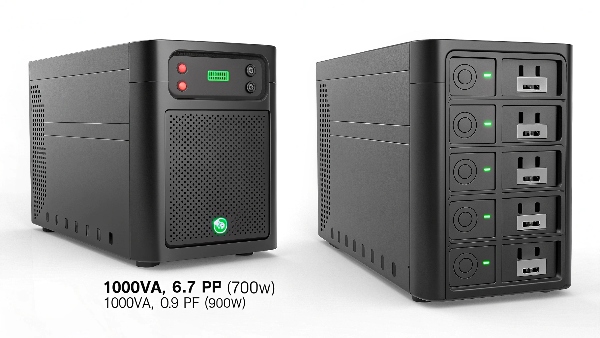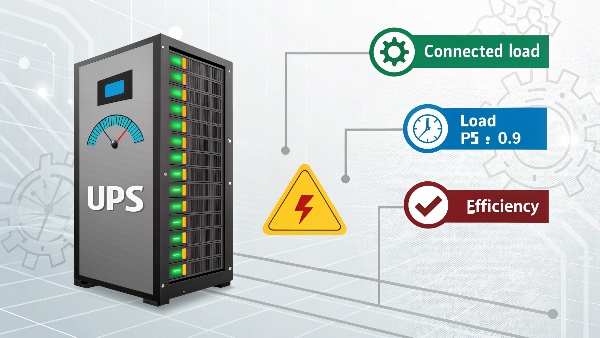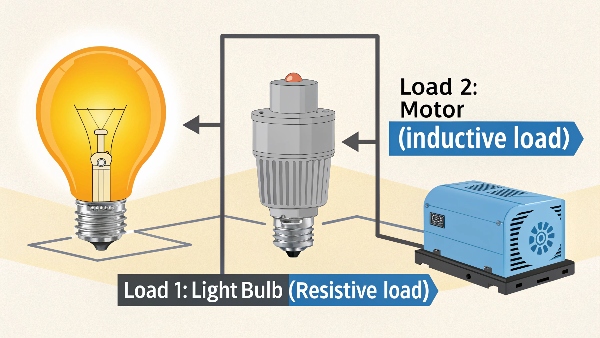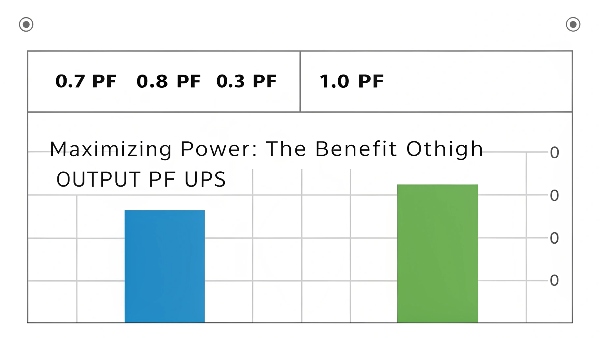Struggling with UPS specs like "power factor"? This seemingly small detail can lead to an undersized UPS, risking your critical equipment when you need it most.
UPS power factor (PF) is the ratio of real power (Watts), which does actual work, to apparent power (VA), which the UPS must handle. A higher power factor means the UPS can deliver more useful power to your equipment for its size.

Transition Paragraph:
Understanding power factor can seem a bit technical, I know. But as someone who's been designing and manufacturing UPS systems at Daopulse for over 10 years, I can tell you it's a crucial number. The power factor of an uninterruptible power supply determines the power capacity of the uninterruptible power supply. While it might not always be the biggest marketing buzzword, getting it right means your UPS will perform as expected. Let's break down what this really means for you.
What is UPS power factor and why does it matter?
Confused by UPS ratings? Power factor seems complex, but ignoring it can mean buying a UPS that can't actually power your essential devices, leading to unexpected shutdowns.
UPS power factor tells you how much of the total power (VA) supplied by the UPS can be used as real working power (Watts) by your equipment. It matters because if the UPS power factor is low, you get less usable power, potentially requiring a larger, more expensive UPS.

Dive deeper Paragraph:
Let me try to simplify this. Think of power in two parts:
- Real Power (Watts or W)1: This is the power that actually does work, like lighting up your screen or running your server's processor. It’s what you truly need.
- Apparent Power (Volt-Amperes or VA)2: This is the total power the UPS has to deliver, including real power and "reactive power3." Reactive power doesn't do useful work but is needed by some devices (like those with motors or older power supplies).
The power factor is simply Watts divided by VA (PF = W/VA). A perfect power factor is 1.0 (meaning W = VA). Older UPS systems often had a power factor of 0.7 or 0.8. This meant a 1000VA UPS with a 0.7 PF could only deliver 700 Watts of real power. Modern IT equipment, which we often supply UPS units for at Daopulse, tends to have a high power factor (close to 1.0). So, matching a high PF UPS with high PF loads is more efficient. The power factor of an uninterruptible power supply determines the power capacity of the uninterruptible power supply in terms of actual work it can support. Understanding this ensures you don't buy a 1000VA UPS thinking it gives 1000W if its PF is only 0.8 (giving 800W).
| Power Factor (PF) | Real Power (Watts) from 1000VA UPS | Implication |
|---|---|---|
| 0.7 | 700 Watts | Less usable power, might need a larger VA UPS |
| 0.8 | 800 Watts | Better, but still not full VA as Watts |
| 0.9 | 900 Watts | Good for most modern IT loads |
| 1.0 (Unity) | 1000 Watts | Most efficient, VA rating equals Watt rating |
Does power factor fluctuation affect my UPS?
Worried that changes in your equipment's power factor might strain your UPS? If your connected devices have a poor or fluctuating power factor, it can indeed impact UPS performance.
Yes, the power factor of your connected load significantly affects the UPS. A load with a low power factor will draw more apparent power (VA) for the same amount of real power (Watts), potentially overloading a UPS sized only for Watts, or reducing its efficiency.

Dive deeper Paragraph:
It's important to distinguish between the UPS's output power factor rating and the power factor of your connected load. A UPS might be rated with an output power factor of, say, 0.9. This means it's designed to efficiently supply loads that also have a power factor around 0.9 or higher.
If you connect equipment with a very low power factor (e.g., 0.6) to this UPS, that equipment will draw a higher apparent power (VA) to get the real power (Watts) it needs. For example, a device needing 600W with a 0.6 PF will draw 1000VA (600W / 0.6 PF = 1000VA). If your UPS is a 1000VA unit with a 0.9 PF (meaning it can supply 900W), it might seem okay from a VA perspective. However, the nature of low power factor loads can stress the UPS components differently.
Most modern electronics, like servers and PCs that our clients like Mr. Li (Procurement Manager) often protect, have power factor corrected (PFC) power supplies. Their power factor is typically high (0.9 to 0.99). This is good news, as it means they draw power efficiently. However, if you have older equipment or devices with motors, their power factor might be lower. The power factor of an uninterruptible power supply determines the power capacity of the uninterruptible power supply, and a mismatch with load PF can effectively reduce that usable capacity. Always consider the worst-case (lowest) power factor of your load when sizing a UPS.
| Load Power Factor | Real Power (W) Demand | Apparent Power (VA) Drawn from UPS | Impact on a 1000VA/900W UPS (0.9 PF rated) |
|---|---|---|---|
| 0.95 (Good) | 850W | ~895VA | UPS operates efficiently, well within capacity. |
| 0.7 (Okay) | 630W | 900VA | UPS is near its VA limit, though Watts are fine. Getting stressed. |
| 0.6 (Poor) | 540W | 900VA | UPS at VA limit. If Watt demand was higher, say 600W (1000VA), it would be overloaded. |
| 0.5 (Very Poor) | 450W | 900VA | UPS at VA limit even with low Watt demand. Highly inefficient. |
Understanding the difference between VA versus Watts?
VA and Watts on a UPS label making your head spin? Getting these two mixed up is a common mistake that can lead to buying the wrong UPS for your needs.
Watts (W) measure real power, the energy actually consumed by your equipment to do work. Volt-Amps (VA) measure apparent power, the total power the UPS must handle, including real power and reactive power. UPS systems are rated in both because your equipment needs both considered.

Dive deeper Paragraph:
I often use an analogy to explain this to clients at Daopulse. Think of a glass of beer. The beer itself is the real power (Watts) – it's what you actually want and can consume. The foam on top is reactive power – it takes up space in the glass but doesn't quench your thirst. The entire glass, beer plus foam, is the apparent power (VA). The UPS has to be big enough to hold the whole glass (VA), even if you only care about the beer (Watts).
So, a UPS is rated in VA because its components (transformer, inverter) must be sized to handle the total current and voltage, regardless of how much is useful power. It's also rated in Watts because that tells you the maximum useful power it can deliver. Most modern IT equipment lists its power consumption in Watts. You should always size your UPS based on the higher of the two requirements when considering your load's VA and Watt needs, and ensure both are within the UPS's VA and Watt ratings. For instance, if your server needs 700W and has a VA rating of 750VA, a UPS rated for 1000VA/900W would be a good fit. The power factor of an uninterruptible power supply determines the power capacity of the uninterruptible power supply, linking these VA and Watt figures.
| Metric | What it Measures | Analogy (Beer) | Why UPS is Rated in It | How Load Uses It |
|---|---|---|---|---|
| Watts (W) | Real Power (Useful Work) | The Beer | Indicates maximum useful power output | Actual energy consumed |
| Volt-Amps (VA) | Apparent Power (Total Power) | Beer + Foam | Indicates total capacity of UPS components (wires, inverter) | Total current drawn |
| Power Factor | Ratio W/VA | Beer / (Beer+Foam) | Defines efficiency in delivering real power for its VA size | Load's efficiency |
What is the significance of UPS output power factor?
Seen UPS units advertised with "unity power factor" or "0.9 PF"? This specification is more than just a number; it directly impacts how much actual power the UPS can provide.
A higher UPS output power factor (closer to 1.0) means the UPS can deliver more real power (Watts) for a given VA rating. This makes it more efficient and better suited for modern IT loads, which typically have high power factors themselves.

Dive deeper Paragraph:
The output power factor of a UPS is a key performance indicator. As we've discussed, the power factor of an uninterruptible power supply determines the power capacity of the uninterruptible power supply in terms of useful Watts. For example:
- A 1000VA UPS with an output power factor of 0.7 can deliver 700 Watts.
- A 1000VA UPS with an output power factor of 0.9 can deliver 900 Watts.
- A 1000VA UPS with a unity power factor (1.0) can deliver 1000 Watts.
At Daopulse, many of our modern UPS systems, especially those designed for data centers and critical infrastructure, boast high output power factors (0.9 or unity). This is because modern servers and networking equipment often have power factor corrected (PFC) power supplies. Their own power factor is very high (close to 1.0). So, a unity power factor UPS is a perfect match, ensuring no "wasted" VA capacity. You get more Watts for your money and for the physical size of the UPS. This translates to better energy efficiency and potentially a smaller footprint UPS for the same Watt load. For Procurement Managers like Mr. Li, this means more effective use of budget and space, which are always important considerations.
| UPS Output PF | For a 5000VA UPS: Max Watt Output | Ideal Load Type | Benefit |
|---|---|---|---|
| 0.7 | 3500 Watts | Older equipment, mixed loads with some low PF devices | Basic protection |
| 0.8 | 4000 Watts | General purpose, some legacy IT equipment | Better Watt delivery than 0.7 PF |
| 0.9 | 4500 Watts | Most modern IT equipment, servers, network gear | Efficient for modern loads, good balance of VA to Watt capacity |
| 1.0 (Unity) | 5000 Watts | Power factor corrected (PFC) IT equipment | Maximum Watt output for VA rating, most efficient, "right-sized" |
Conclusion
Understanding UPS power factor ensures you select a unit that truly matches your equipment's needs, providing reliable power by delivering the necessary Watts efficiently without being undersized or oversized.
-
Understanding Real Power is crucial for optimizing energy usage and efficiency in electrical systems. ↩
-
Exploring Apparent Power helps clarify its role in electrical systems and its importance for device compatibility. ↩
-
Learning about reactive power is essential for grasping how electrical systems function and ensuring device performance. ↩

